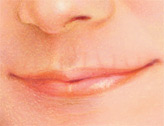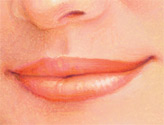If you’d like to restore youthful fullness to your face, enjoy plump lips, enhance shallow contours or soften those facial creases and wrinkles, dermal fillers may be the answer. Dermal fillers have been called “liquid facelifts” because they offer many of the benefits of a surgical facelift without the downtime.
Although they can’t help with excess sagging skin, these soft tissue fillers can add more volume and provide immediate results at a lower cost than surgery. These treatment aren’t permanent, however, and they must be repeated and maintained.
Some dermal fillers are used in conjunction with other skin rejuvenation treatments such as injections of botulinum toxin. Your plastic surgeon will assess your needs and recommend one or a combination of treatments to achieve your desired results.
Are Injectable Fillers Right for You?
Dermal fillers are wonderful to rejuvenate your appearance, but they can’t stop the aging process. If you want a permanent solution, talk to your doctor about a facelift, brow lift or eye lift.
Some people opt to have a liquid facelift, delaying the time when a surgical facelift is more appropriate. It’s a great way to see some impressive changes and improvements in your appearance, such as the reduction of forehead wrinkles, until you’re ready for a permanent surgical option.
Just remember, you’ll need to have repeat treatments with dermal fillers as a wrinkle treatment to maintain that fresh, full new look.
Injectable fillers can help improve the skin’s texture by filling in the laugh lines and facial creases that often occur with aging.
Years of squinting, smiling and other facial muscle movements can lead to lines and wrinkles around the mouth and nose.
After treatment, the skin around the mouth area appears smoother and tauter.
The lips can become thinner or flatter over time.
Soft tissue augmentation of the lips can enhance lip fullness and raise or define the cupid’s bow or vermillion border.
How Wrinkle Fillers Work
Wrinkle fillers can be divided into two categories: Temporary and Semi-Permanent.
Temporary Fillers
Human fat, also known as autologous fat, is harvested from your own body. Using your own fat requires a more extensive procedure than other injectable fillers because you first must undergo liposuction to extract the fat prior to injection. You eliminate the risk of allergic reaction or rejection by the body by using your own fat. You should know that not all of the live fat cells survive when transplanted into a new site. You can expect a fairly high rate of re-absorption. Because of this, your doctor will likely overfill the area being treated. At first you might look abnormal, but it will soon settle and you’ll enjoy a new look. When your doctor extracts this fat via liposuction, it’s possible that there will be more than is needed for one application. Most natural fat can be stored for touch-ups.
Collagen is a natural substance known as a protein, and the main component in cartilage, teeth and bones. It is derived either from human skin or cows (known as bovine collagen). Brand names include: CosmoDerm, Cosmoplast, Zyderm, Zyplast.
Human cadaveric dermis is skin that’s cultivated from a cadaver, then injected into your face. This substance results in particularly impressive filling of facial hollows. Brand names include: Cymetra, Dermalogen, Fascian.
Hyaluronic acid is also a natural substance found in your body. High concentrations are found in soft connective tissue and in the fluid surrounding your eyes. It’s also in some cartilage and joint fluids, as well as skin tissue. If the name sounds familiar, it’s because the same substance is often injected into the aching joints of people with arthritis to ease pain by providing extra cushioning. Hyaluronic acid is not derived from animal sources. Our aesthetician may use Juvéderm® or Restylane® depending on your individual needs.
Calcium hydroxylapatite, the heaviest of facial fillers, is found naturally in human bones. This mineral-like compound is reserved to fill the deepest creases such as nasolabial folds, marionette lines and frown lines. It’s also used to enhance fullness of the cheeks and other facial contours. Calcium-based microspheres are suspended in a water-based gel. Brand names include: Radiesse, Radiance.
Polylactic acid is a synthetic material. When it is injected, it stimulates the body’s own production of collagen. This substance is known to work particularly well in the lower half of your face to fill the lines caused by laughing, to augment thin lips and fill out deep nasolabial folds. This substance is unlike other dermal fillers because it doesn’t produce immediate results. Instead, it stimulates collagen production, so results appear gradually over a period of a few months. Brand names include: Sculptra, New-Fill.
When injected beneath the skin, these fillers plump up creased and sunken areas of the face. They can also add fullness to the lips and cheeks. Injectable fillers may be used alone or in conjunction with a resurfacing procedure, such as a laser treatment, or a recontouring procedure, such as a facelift.
Semi-Permanent Fillers
PMMA (polymethylmethacrylate) fillers contain about 20 percent of tiny PMMA microspheres that are suspended in 80 percent purified collagen gel. This substance, considered semi-permanent, can be removed. PMMA is most often used to treat medium-to-deep wrinkles, folds and furrows, particularly nasolabial folds. It can also be used to fill out pitted scars and to augment thin lips. PMMA has been used for many years in permanent surgical implants. Because of this, your surgeon will likely under-fill on the first treatment, adding more later if needed. Brand names include: Articol, Artefill, Metacrill.
What happens during dermal filler injections?
Assess.
First, your surgeon will listen to your desired results and then evaluate your facial appearance and skin tone, examining the areas of your face to be augmented with a cosmetic dermal filler.
Map a strategy.
Next, the surgeon will mark strategic points on your face as guides to the appropriate injection sites for the filler.
Clean the area.
Your injection sites will be cleansed with an antibacterial agent. Then a topical anesthetic will be used to numb the area, particularly if you are sensitive to injections. In some cases, the dermal filler includes an anesthetic in the mixture.
Inject.
The actual injections will take just a few minutes total, and just seconds per site.
Clean up and ice.
The marks will be washed away and you will be offered an ice pack to reduce any minor and temporary discomfort. At this point you may apply makeup, but be careful not to apply pressure to the treated areas. Doing so may result in movement of the dermal filler.
A special note about scars and deep lines: these areas will often require multiple injections to achieve your desired results. If a deeper injection is required, you’ll be offered a local anesthetic to remain comfortable. Common sites for deeper tissue fillers are the nasolabial folds and marionette lines, or to enhance fullness in the cheeks.
Risks Related to Injectables
When injectables are administered by a qualified plastic surgeon, complications are infrequent and usually minor in nature. Still, individuals vary greatly in their anatomy, their physical reactions and their healing abilities. The outcome of treatment with injectables is never completely predictable.
Hyaluronic Acid: side effects are typically mild or moderate in nature and last for less than 7 days. Adverse events include redness, pain, firmness, swelling, lumps/bumps, bruising, itching, and discoloration.
Collagen: Allergic reaction is the primary risk of collagen. To help determine if you are allergic to the substance, your surgeon will perform an allergy skin test about a month before the procedure. After the test is performed, the test site should be watched carefully for three or four weeks, or as long as your surgeon advises. Any sign of redness, itching, swelling or other occurrences at the test site should be reported to your surgeon.
Risks not necessarily related to allergies include infection, abscesses, open sores, skin peeling, scarring and lumpiness, which may persist over the treated area. Reports of these problems are very rare.
Fat: Allergic reaction is not a factor for fat because it’s harvested from a patient’s own body. However, there is still a small risk of infection and other infrequent complications.
Planning for Treatment
Facial rejuvenation is very individualized. That’s why it’s important to discuss your hopes and expectations with a board-certified plastic surgeon who has experience with many different types of surgical and non-surgical facial procedures.
In your initial consultation, your plastic surgeon will evaluate your face – the skin, the muscles and the underlying bone – and discuss your goals for the surgery. Your doctor will help you select a treatment option based on your goals and concerns, your anatomy and your lifestyle.
Your surgeon will ask you about your medical history, drug allergies, and check for conditions that could cause problems, such as active skin infections or non-healed sores from injuries. Collagen injections are generally off limits for pregnant women, individuals who are allergic to beef or bovine products, patients who suffer from autoimmune diseases, and those who are allergic to lidocaine (the anesthetic agent contained in the syringe with the collagen material). For more specific information about the contraindications and risks of collagen use, ask your doctor for the manufacturer’s brochure for patients.
Insurance usually doesn’t cover cosmetic procedures. However, if your injectable treatment is being performed to treat a scar or indentation from an accident or injury, you may be reimbursed for a portion of the cost. Check with your insurance carrier to be sure.
Injectables are usually administered in a surgeon’s office-based facility. If, however, you are being hospitalized for a facelift, neck lift, brow lift, or any other procedure, your injections may be administered in the hospital as well.
Types of Anesthesia
Collagen: Because the anesthetic agent lidocaine is mixed in with collagen, additional anesthetic is usually not used. However, if you are especially sensitive to pain, your doctor may use a topical cream anesthetic or a Freon spray to numb the injected area. Or, you may elect to have an injected local anesthetic or sedative drugs.
Fat: Both the donor and recipient sites are numbed with local anesthesia. Sedation can be used as well. If you elect to use sedation, be sure to arrange for a ride home after your treatment.
Your New Look
If you’re like most patients, you’ll be very satisfied with the results of your injectable treatments. You may be surprised at the pleasing results that can be gained from this procedure.
Please call us at (732) 219-0447 to schedule your consultation or contact us via online form.







